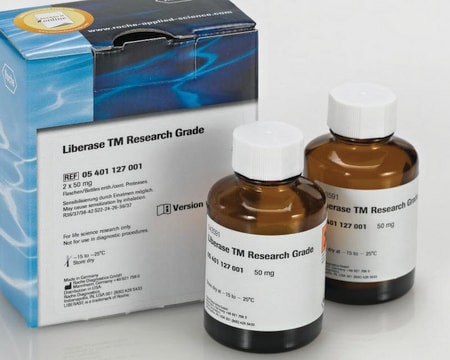Key Documents
04716728001
Roche
DNase I recombinant, RNase-free
from bovine pancreas, expressed in Pichia pastoris
About This Item
Polecane produkty
pochodzenie biologiczne
bovine pancreas
Poziom jakości
rekombinowane
expressed in Pichia pastoris
Postać
solution
masa cząsteczkowa
~39 kDa
opakowanie
pkg of 10,000 U
producent / nazwa handlowa
Roche
optymalne pH
7.0-8.0
Powiązane kategorie
Opis ogólny
Contents
- Recombinant DNase I, RNase-free, 10 U/μl
- Incubation Buffer, 10x concentrated
Specyficzność
Important Note: Alternatively, DNase I recombinant, RNase-free can be inactivated and removed by phenol extraction according to standard protocols, e.g., Current Protocols in Molecular Biology.
Zastosowanie
- Remove genomic DNA from RNA preparations prior to RT-PCR
- Isolate DNA-free RNA after in vitro transcription reactions
- Perform nick translations
- Map DNase-sensitive regions in eukaryotic DNA
Cechy i korzyści
- Eliminates DNA contamination from any RNA sample
- Contains no detectable RNase or protease activity
- Can be heat inactivated, thereby eliminating the need for organic extraction
- Shipped with an optimized incubation buffer, which supports maximum DNase activity
- Produced via an entirely animal-free process, to eliminate any risks associated with animal-derived material
Opakowanie
Jakość
Charakterystyka techniczna
Recombinant DNase I is heterogeneously N-glycosylated, so it appears as two bands in gel electrophoresis.
Divalent ion requirement
DNase I requires divalent cations for maximum activity. The DNA-specific endonuclease is activated by ions such as magnesium ions and is stimulated by calcium ions. Therefore, the enzyme is inhibited by metal chelating agents like EDTA.
Definicja jednostki
Assay conditions:
Volume activity is determined according to the following assay mixture. 100 μg calf thymus DNA is incubated in 2.5 ml 1x incubation buffer with 40 to 70 units DNase I recombinant, RNase-free at +25 °C. The absorbance increase is measured at 260 nm.
Uwaga dotycząca przygotowania
Working solution: Storage Buffer: 20 mM Tris-HCl, 50 mM NaCl, 2 mM CaCl2, 2 mM MgCl2, 1 mM dithioerythritol, 0.1 mg/ml Pefabloc SC, 50% glycerol (v/v), pH 7.6 (at 4 °C).
Incubation Buffer (10x): 400 mM Tris-HCl, 100 mM NaCl, 60 mM MgCl2, 10 mM CaCl2, pH 7.9.
Enzyme Dilution Buffer: 25 mM Tris-HCl, 50% glycerol (v/v), pH 7.6 (at 4 °C).
Przechowywanie i stabilność
Inne uwagi
Kod klasy składowania
12 - Non Combustible Liquids
Klasa zagrożenia wodnego (WGK)
WGK 1
Temperatura zapłonu (°F)
does not flash
Temperatura zapłonu (°C)
does not flash
Certyfikaty analizy (CoA)
Poszukaj Certyfikaty analizy (CoA), wpisując numer partii/serii produktów. Numery serii i partii można znaleźć na etykiecie produktu po słowach „seria” lub „partia”.
Masz już ten produkt?
Dokumenty związane z niedawno zakupionymi produktami zostały zamieszczone w Bibliotece dokumentów.
Klienci oglądali również te produkty
Produkty
rganoid culture products to generate tissue and stem cell derived 3D brain, intestinal, gut, lung and cancer tumor organoid models.
Produkty do hodowli organoidalnej do generowania trójwymiarowych modeli mózgu, jelit, jelit, płuc i guzów nowotworowych pochodzących z tkanek i komórek macierzystych.
Protokoły
DNase I from bovine pancreas is a glycoprotein of Mr 37000. A special procedure is used to remove RNases from the DNase preparation.
DNaza I z trzustki bydlęcej jest glikoproteiną o Mr 37000. W celu usunięcia RNaz z preparatu DNazy stosuje się specjalną procedurę.
Nasz zespół naukowców ma doświadczenie we wszystkich obszarach badań, w tym w naukach przyrodniczych, materiałoznawstwie, syntezie chemicznej, chromatografii, analityce i wielu innych dziedzinach.
Skontaktuj się z zespołem ds. pomocy technicznej










